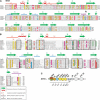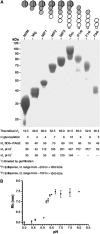Molecular analysis of receptor protein tyrosine phosphatase mu-mediated cell adhesion
- PMID: 16456543
- PMCID: PMC1383555
- DOI: 10.1038/sj.emboj.7600974
Molecular analysis of receptor protein tyrosine phosphatase mu-mediated cell adhesion
Abstract
Type IIB receptor protein tyrosine phosphatases (RPTPs) are bi-functional cell surface molecules. Their ectodomains mediate stable, homophilic, cell-adhesive interactions, whereas the intracellular catalytic regions can modulate the phosphorylation state of cadherin/catenin complexes. We describe a systematic investigation of the cell-adhesive properties of the extracellular region of RPTPmu, a prototypical type IIB RPTP. The crystal structure of a construct comprising its N-terminal MAM (meprin/A5/mu) and Ig domains was determined at 2.7 A resolution; this assigns the MAM fold to the jelly-roll family and reveals extensive interactions between the two domains, which form a rigid structural unit. Structure-based site-directed mutagenesis, serial domain deletions and cell-adhesion assays allowed us to identify the four N-terminal domains (MAM, Ig, fibronectin type III (FNIII)-1 and FNIII-2) as a minimal functional unit. Biophysical characterization revealed at least two independent types of homophilic interaction which, taken together, suggest that there is the potential for formation of a complex and possibly ordered array of receptor molecules at cell contact sites.
Figures





Similar articles
-
Homophilic interactions mediated by receptor tyrosine phosphatases mu and kappa. A critical role for the novel extracellular MAM domain.J Biol Chem. 1995 Jun 16;270(24):14247-50. doi: 10.1074/jbc.270.24.14247. J Biol Chem. 1995. PMID: 7782276
-
Structure of a tyrosine phosphatase adhesive interaction reveals a spacer-clamp mechanism.Science. 2007 Aug 31;317(5842):1217-20. doi: 10.1126/science.1144646. Science. 2007. PMID: 17761881
-
The MAM (meprin/A5-protein/PTPmu) domain is a homophilic binding site promoting the lateral dimerization of receptor-like protein-tyrosine phosphatase mu.J Biol Chem. 2004 Jun 25;279(26):26922-31. doi: 10.1074/jbc.M313115200. Epub 2004 Apr 14. J Biol Chem. 2004. PMID: 15084579
-
Receptor protein tyrosine phosphatases as mediators of cellular adhesion.Front Biosci. 2003 Jan 1;8:d87-99. doi: 10.2741/941. Front Biosci. 2003. PMID: 12456340 Review.
-
Receptor protein tyrosine phosphatase micro: measuring where to stick.Biochem Soc Trans. 2008 Apr;36(Pt 2):167-72. doi: 10.1042/BST0360167. Biochem Soc Trans. 2008. PMID: 18363557 Review.
Cited by
-
Role of Neuropilin-1 in Diabetic Nephropathy.J Clin Med. 2015 Jun 17;4(6):1293-311. doi: 10.3390/jcm4061293. J Clin Med. 2015. PMID: 26239560 Free PMC article. Review.
-
Dimerization of protein tyrosine phosphatase sigma governs both ligand binding and isoform specificity.Mol Cell Biol. 2007 Mar;27(5):1795-808. doi: 10.1128/MCB.00535-06. Epub 2006 Dec 18. Mol Cell Biol. 2007. PMID: 17178832 Free PMC article.
-
Construction of the miRNA-mRNA Regulatory Networks and Explore Their Role in the Development of Lung Squamous Cell Carcinoma.Front Mol Biosci. 2022 May 31;9:888020. doi: 10.3389/fmolb.2022.888020. eCollection 2022. Front Mol Biosci. 2022. PMID: 35712349 Free PMC article.
-
Receptor protein tyrosine phosphatases and cancer: new insights from structural biology.Cell Adh Migr. 2012 Jul-Aug;6(4):356-64. doi: 10.4161/cam.21242. Epub 2012 Jul 1. Cell Adh Migr. 2012. PMID: 22796942 Free PMC article. Review.
-
Structural and evolutionary insights into astacin metallopeptidases.Front Mol Biosci. 2023 Jan 4;9:1080836. doi: 10.3389/fmolb.2022.1080836. eCollection 2022. Front Mol Biosci. 2023. PMID: 36685277 Free PMC article.
References
-
- Aricescu AR, Fulga TA, Cismasiu V, Goody RS, Szedlacsek SE (2001) Intramolecular interactions in protein tyrosine phosphatase RPTPmu: kinetic evidence. Biochem Biophys Res Commun 280: 319–327 - PubMed
-
- Beckmann G, Bork P (1993) An adhesive domain detected in functionally diverse receptors. Trends Biochem Sci 18: 40–41 - PubMed
-
- Beltran PJ, Bixby JL (2003) Receptor protein tyrosine phosphatases as mediators of cellular adhesion. Front Biosci 8: d87–d99 - PubMed
-
- Bianchi C, Sellke FW, Del Vecchio RL, Tonks NK, Neel BG (1999) Receptor-type protein-tyrosine phosphatase mu is expressed in specific vascular endothelial beds in vivo. Exp Cell Res 248: 329–338 - PubMed
Publication types
MeSH terms
Substances
Grants and funding
LinkOut - more resources
Full Text Sources
Other Literature Sources
Molecular Biology Databases
Research Materials

